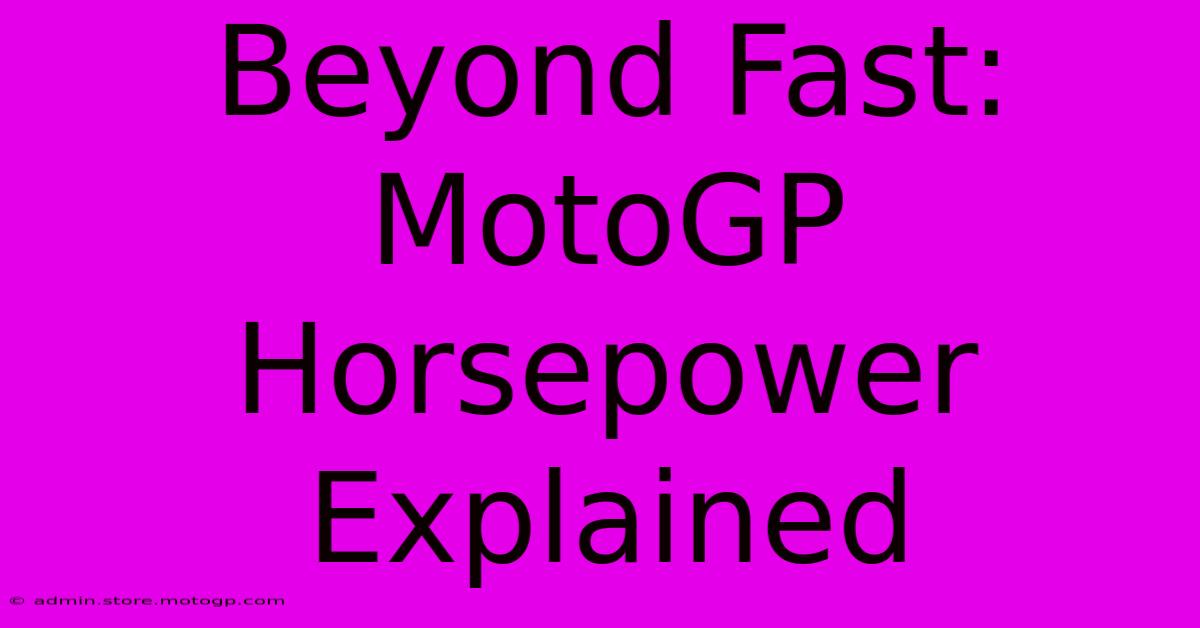Beyond Fast: MotoGP Horsepower Explained

Table of Contents
Beyond Fast: MotoGP Horsepower Explained
MotoGP. The name itself conjures images of screaming engines, breathtaking speeds, and gravity-defying maneuvers. But what truly fuels these incredible feats of athleticism and engineering? The answer, simply put, is horsepower. But it's not just about the raw numbers; it's about the kind of horsepower, how it's delivered, and the sophisticated technology that makes it all possible. This article delves into the fascinating world of MotoGP horsepower, exploring the factors that contribute to its explosive power and the constant push for innovation.
The Untamed Power: How Much Horsepower Does a MotoGP Bike Have?
While exact figures are closely guarded secrets by the manufacturers, estimates place the horsepower of a modern MotoGP bike at around 260 bhp. However, it's crucial to understand that this figure is often measured at the crankshaft and doesn't account for transmission losses. The actual power reaching the rear wheel is slightly lower, but still incredibly impressive.
This immense power output is achieved through a combination of factors:
- Engine Capacity: MotoGP bikes utilize highly tuned 1000cc inline four-cylinder engines. This relatively large capacity allows for significant power generation.
- High RPM: These engines operate at exceptionally high RPMs (revolutions per minute), often exceeding 16,000 RPM. This high speed allows for more power strokes per unit of time.
- Sophisticated Engine Design: Advanced technologies like pneumatic valve systems, seamless shift transmissions, and sophisticated electronics contribute significantly to the power output and efficient delivery.
- Aerodynamics: The aerodynamic design of the bikes, including winglets and fairings, plays a crucial role in managing airflow and maximizing downforce, allowing for even greater speeds and acceleration.
Beyond the Numbers: The Importance of Power Delivery
Simply having high horsepower isn't enough. The way that power is delivered is just as crucial. MotoGP bikes are designed to have exceptional torque, the twisting force that accelerates the bike. This means the power is not only substantial but also readily available across a wide range of RPMs. This allows riders to smoothly accelerate out of corners and maintain high speeds through challenging sections of the track.
The Technological Marvels: Engine Innovations in MotoGP
The relentless pursuit of performance in MotoGP has led to incredible technological advancements. Some key innovations driving horsepower gains include:
- Pneumatic Valve Systems: These systems use compressed air to control valve timing, allowing for incredibly precise and rapid valve actuation. This contributes to higher RPMs and improved combustion efficiency.
- Seamless Shift Transmissions: These transmissions allow for gear changes without interrupting power delivery, resulting in smoother acceleration and improved lap times.
- Ride-by-Wire Systems: These systems use electronic controls to manage throttle response, offering precise control and customization for different track conditions.
- Sophisticated Engine Management Systems: These systems use sensors to monitor various engine parameters and adjust fuel injection and ignition timing in real-time, maximizing power output and efficiency.
The Future of MotoGP Horsepower
The quest for even greater horsepower in MotoGP is ongoing. Manufacturers constantly strive to improve engine efficiency, reduce weight, and refine aerodynamic design. While the regulations aim to balance competition, the pursuit of innovation ensures that the power and excitement of MotoGP will continue to evolve. Future developments might include:
- Hybrid Powertrains: While unlikely in the near future, incorporating hybrid technology could bring significant performance gains while addressing environmental concerns.
- Further refinements to engine designs: Minor tweaks and advancements in materials science could unlock further incremental power increases.
- Advanced Aerodynamics: Continued research into aerodynamics will allow for better management of airflow and improved downforce, indirectly enhancing performance.
In Conclusion: The horsepower of a MotoGP bike is not just a number; it represents the pinnacle of motorcycle engineering. The combination of high engine capacity, sophisticated technology, and precise power delivery creates an exhilarating spectacle for fans worldwide. As the sport continues to evolve, we can expect to see further advances in power and performance pushing the boundaries of what's possible.

Thank you for visiting our website wich cover about Beyond Fast: MotoGP Horsepower Explained. We hope the information provided has been useful to you. Feel free to contact us if you have any questions or need further assistance. See you next time and dont miss to bookmark.
Featured Posts
-
Moto Gp Qualifying Under Pressure
Feb 18, 2025
-
Moto Gp Crash Inspiring Future Generations
Feb 18, 2025
-
Dont Miss The Action Malaysian Motorcycle Grand Prix Tickets Now Available
Feb 18, 2025
-
Cota Lot H A Vision For The Future
Feb 18, 2025
-
Moto Gp Qualifying Understanding The Fight For Pole
Feb 18, 2025
